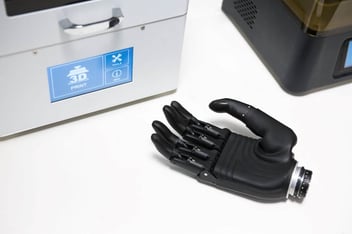How to Attract Patients to Your O&P Practice
As an orthotics and prosthetics practice, attracting and retaining patients can be challenging. While there are millions of limb loss patients around the world, they may all be searching for different solutions. Consequently, it’s important to showcase your professional talents as a clinician as well as offer custom solutions to your patients’ needs.
But, not to worry. We’ve collected a list of tips and tricks to help you attract patients to your O&P practice (as well as hone in on the value you deliver to them). If you’re looking to grow your practice, you’re in the right place.
Start-to-Finish Experience
One of the most important considerations patients have when searching for an O&P practice is an all-inclusive experience. Your practice should serve as a one-stop shop for all of your patients’ needs.
When a patient enters your practice, the odds are that they are starting from scratch. This means they may have recently had surgery, are still undergoing physical therapy, or are searching for their first prosthetic hand. Whatever the case, they rely on your practice to guide them through new and unfamiliar territory.
Consequently, patients want your practice to meet all of their needs. Going to several doctors and prosthetists for each step of the process is tedious and doesn’t do much to enhance the patient experience.
Instead, your practice should cater to patients all the way from a physical exam, prosthesis selection, fitting the prosthesis to the patient, to teaching patients to operate their new hand. The more holistic an experience you can offer to patients, the more inclined they will be to work with (and stay with) your practice.
To break it down for you, the entire patient experience should include:
- Patient meets with your care team to develop goals and needs
- Patient health evaluation to determine prosthesis options
- Prosthesis selection
- Fit patient to a prosthesis
- Rehabilitation and training
If your practice can support patients throughout each step of this process, you’re one step closer to attracting new patients - and retaining the ones you already have.
Offer a Variety of Options
No two patients are the same and shouldn’t be treated as if they are. Each patient will have unique needs in terms of health and personal preferences. While one patient may only want a prosthetic hand for aesthetic purposes, another may seek a high-functioning device capable of supporting them in a variety of activities.
With this in mind, your O&P practice should be able to cater to different patient needs and preferences by offering a wide variety of prostheses. When it comes to prosthetic hands, there are many to choose from:
- Passive prosthesis
- Body-powered prosthesis
- Externally-powered prosthesis
- Bionic hand
- Hybrid prosthetic
- Activity/recreation/vocation specific
Referring back to the previous example, the first patient who is looking for a prosthesis for solely anatomical aesthetic purposes would most likely want a passive prosthesis. In contrast, the patient seeking a higher functioning hand would likely benefit from a bionic hand. The passive prosthesis will meet aesthetic needs, while the bionic hand can support the patient in more complex movements that require strength and dexterity.
Whatever a patient’s needs may be, offering a wide variety of prosthetic hand options will make them more inclined to work with your O&P practice than alternative prosthetists.
Work with Patients
Another excellent way to cater to the patient experience and, thus, attract more patients is to work with patients. While this may seem obvious, many practices fail to do this in a holistic sense. While the most basic purpose of your O&P practice is to provide patients with prostheses, a desirable practice will offer much more.
Beyond getting patients matched with a prosthetic hand, your practice can offer additional services such as occupational therapy, training, and teaching patients how to operate and maintain their prosthetic hand.
As mentioned, many of the patients you see will be new to the prosthetic experience. As a result, you are responsible for guiding them through the process. Teaching them the basics of prosthetics and how to use their new hand is essential.
Particularly for prostheses such as bionic hands, teaching patients to operate their hand is crucial. If you can offer patients state-of-the-art bionic hands and help them become familiarized with it, you can create a service offering that not many other practices have.
Open a Discussion
In the same sense as working with patients to achieve their end goal, creating an open discussion with patients is also beneficial. Many patients with limb loss are learning to cope with their mental health surrounding the loss of their limb and discomfort with their body and prosthetic hand. In opening this conversation, you can not only improve the success rates of patients with their hands but also build a relationship with them.
Openly talking and following up with patients about their recovery and experience can work wonders to improve their experience with your practice. Offering resources surrounding common questions and maintenance needs can also benefit you and your patients.
Offer a Hand like No Other
While some patients may enter your practice with no idea of what they want or what to expect, others will come in having done some research. If this is the case, they may know exactly what kind of prosthetic hand they want.
Bionic hands are vastly growing in popularity due to their strength, functionality, flexibility, and durability. Patients are discovering that with a bionic hand, there is little that they can’t do. As a prosthetist, this discovery is something to celebrate! Your end goal with each patient should be to provide the perfect prosthetic hand for them - and for many, that is a bionic hand.
However, there are many bionic hands on the market, so your practice should be mindful of choosing the right one to offer. Fortunately, we can help you with this as well. Zeus is a high-functioning, multi-articulating bionic hand. With the Zeus, patients can benefit from:
- Unprecedented strength
- Remote configuration
- Local repairability
- Customization of 12 standard grips
- Flexible and durable fingers
By adding Zeus to your portfolio of offerings, your practice can offer patients a bionic hand like no other. Even beyond its vast capabilities, Zeus is designed to be an affordable bionic hand, ensuring that it is accessible to users of all backgrounds. Consequently, your practice can offer a high-quality bionic hand at a price point within reach of all users. As such, you can attract a whole new pool of patients and vastly grow your practice.
If you’re interested in offering Zeus at your O&P practice, contact one of our team members.











